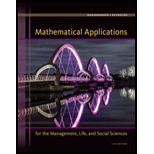
Concept explainers
(a)
To calculate: The function for the instantaneous rate of change of Alzheimer’s disease
(b)
To calculate: The instantaneous rate of change of the percent of the U.S population with Alzheimer’s disease in 2025 and estimate its interpretation also, if the baby boomer generation ages and the proportion of the U.S. population over 65 increases, the number of Americans with Alzheimer’s disease and other dementia is projected to grow each year. With data from the Social Security Alzheimer’s Association for selected years from 2000 and projected to 2050, the Alzheimer’s can be modeled by
Want to see the full answer?
Check out a sample textbook solution
Chapter 9 Solutions
Mathematical Applications for the Management, Life, and Social Sciences
- Starting with the finished version of Example 6.2, attached, change the decision criterion to "maximize expected utility," using an exponential utility function with risk tolerance $5,000,000. Display certainty equivalents on the tree. a. Keep doubling the risk tolerance until the company's best strategy is the same as with the EMV criterion—continue with development and then market if successful. The risk tolerance must reach $ ____________ before the risk averse company acts the same as the EMV-maximizing company. b. With a risk tolerance of $320,000,000, the company views the optimal strategy as equivalent to receiving a sure $____________ , even though the EMV from the original strategy (with no risk tolerance) is $ ___________ .arrow_forward2.8.1arrow_forwardDo not use the Residue Theorem. Thank you.arrow_forward
- A television network earns an average of $14 million each season from a hit program and loses an average of $8 million each season on a program that turns out to be a flop. Of all programs picked up by this network in recent years, 25% turn out to be hits and 75% turn out to be flops. At a cost of C dollars, a market research firm will analyze a pilot episode of a prospective program and issue a report predicting whether the given program will end up being a hit. If the program is actually going to be a hit, there is a 75% chance that the market researchers will predict the program to be a hit. If the program is actually going to be a flop, there is only a 30% chance that the market researchers will predict the program to be a hit. What is the maximum value of C that the network should be willing to pay the market research firm? Enter your answer in dollars, not in million dollars. $ __________ Calculate EVPI for this decision problem. Enter your answer in dollars, not in million…arrow_forwardEvaluate the line integral sin z dz, So sin where C is the portion of the curve y = x² from 0 to −1 + i.arrow_forwardLet f(z) be complex differentiable everywhere in C. Fix two distinct complex numbers a and b and a circle C of radius R with |a| < R,|b| < R traversed in the counter-clockwise direction. Evaluate the integral Sc − f(z)dz (z - a)(z – b) in terms of a, b and the values of f at those points.arrow_forward
- | Let C be a circle (with a positive radius) such that z = 1 lies in its interior. Evaluate the contour integral So Tz zez (z - 1)³ = where C is traversed in the clockwise direction. dzarrow_forwardquestion 8arrow_forwardTwo construction companies are bidding against one another for the right to construct a new community center building. The first construction company, Fine Line Homes, believes that its competitor, Buffalo Valley Construction, will place a bid for this project according to the distribution shown in this table: Buffalo Valley's Bid Bid Probability $160,000 0.2 $165,000 0.5 $170,000 0.2 $175,000 0.1 Furthermore, Fine Line Homes estimates that it will cost $160,000 for its own company to construct this building. Given its fine reputation and long-standing service within the local community, Fine Line Homes believes that it will likely be awarded the project in the event that it and Buffalo Valley Construction submit exactly the same bids. Find the bid that maximizes Fine Line’s expected profit. Max expected profit $ ________ . Bid that maximizes profit $ ________ .arrow_forward
 Glencoe Algebra 1, Student Edition, 9780079039897...AlgebraISBN:9780079039897Author:CarterPublisher:McGraw Hill
Glencoe Algebra 1, Student Edition, 9780079039897...AlgebraISBN:9780079039897Author:CarterPublisher:McGraw Hill Algebra & Trigonometry with Analytic GeometryAlgebraISBN:9781133382119Author:SwokowskiPublisher:Cengage
Algebra & Trigonometry with Analytic GeometryAlgebraISBN:9781133382119Author:SwokowskiPublisher:Cengage Big Ideas Math A Bridge To Success Algebra 1: Stu...AlgebraISBN:9781680331141Author:HOUGHTON MIFFLIN HARCOURTPublisher:Houghton Mifflin Harcourt
Big Ideas Math A Bridge To Success Algebra 1: Stu...AlgebraISBN:9781680331141Author:HOUGHTON MIFFLIN HARCOURTPublisher:Houghton Mifflin Harcourt College Algebra (MindTap Course List)AlgebraISBN:9781305652231Author:R. David Gustafson, Jeff HughesPublisher:Cengage Learning
College Algebra (MindTap Course List)AlgebraISBN:9781305652231Author:R. David Gustafson, Jeff HughesPublisher:Cengage Learning Algebra and Trigonometry (MindTap Course List)AlgebraISBN:9781305071742Author:James Stewart, Lothar Redlin, Saleem WatsonPublisher:Cengage Learning
Algebra and Trigonometry (MindTap Course List)AlgebraISBN:9781305071742Author:James Stewart, Lothar Redlin, Saleem WatsonPublisher:Cengage Learning





